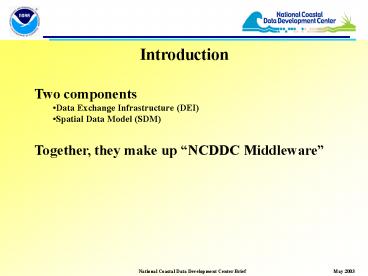Two components - PowerPoint PPT Presentation
1 / 20
Title:
Two components
Description:
... Coastal Data Development Center Brief. Introduction. Two components ... Introduction to NCDDC Middleware - what it does and why. Richard Owens. May 2003 ... – PowerPoint PPT presentation
Number of Views:14
Avg rating:3.0/5.0
Title: Two components
1
Introduction
- Two components
- Data Exchange Infrastructure (DEI)
- Spatial Data Model (SDM)
- Together, they make up NCDDC Middleware
2
Introduction to NCDDC Middleware - what it does
and why
- Richard Owens
3
What Is DEI (High-level overview)
DEI is a client/server framework by which
applications and data repositories can interact.
The goal of the framework is to solve the
problems of Data Access and Data
Representation. DEI is a CORBA-based set of
interfaces which are used to locate and transfer
geospatial data. It is a client/server
architecture which uses CORBA's IIOP (uses TCP)
as its transport protocol.
4
DEI Concepts
- Gateway
- Server component that adapts DEI interfaces to a
specific - data source
- Data source dependent
- DEI Client
- Any software that uses DEI CORBA interfaces to
- communicate with gateways
CORBA
Client
Gateway
5
DEI Concepts (continued)
- Data Flavor (formats)
- Like a MIME type
6
What DEI Is Not
Complete
- Lacks generic query processing
- Poor support for very large datasets
Data Archive/Storage Data Format
- Supports them, though
Web services
(graphic here)
7
History Originally Navy NRL funded project Now
being developed by NCDDC Current Status Java
based gateways via Java GDK Current focus C
gateways Original focus, now lagging behind
Java Future Mature Java GDK, then C GDK Add
generic query processing Add support for very
large datasets Open source
8
- What is the SDM
- Object-oriented library that is used to
represent and manipulate spatial data objects. - 3D
- Some other dimensional capabilities, too
- Structured Grids
- Regular, Rectilinear, Curvilinear, Projected
- Unstructured Grids
- Coordinate Systems
- Cartographic, Cartesian, Cylindrical, Spherical
- GIS-like structures
- Points, Lines, Polygons, etc.
9
- What is the SDM (continued)
- Java
- 160 classes
- 1050 Unit tests
10
Key Features
- Called the Field Spatial Data Model by its
developer because it uses a field concept,
which relates spatial objects to data. - Fundamental storage is multi-dimensional array.
- Decoupling of data storage from its geometry and
topology. - Requires basic metadata (quantity, units,
validity, accuracy, etc.) for all data. - Aids in interoperability
11
Key Features (continued)
- Small, consistent API for data access.
- The SDM hides all implementation details of data
representation behind its abstract interfaces. - Decouples many issues regarding storage and
internal representation of the data, while
providing a consistent interface to it. - Data may be logically represented one way and
physically stored another way. - Many manipulations may be done without actually
having to have the data physically in memory.
12
Key Features (continued)
- Externalized format for representing datasets
- XML based (FDML)
- Can be generated without the use of the SDM.
13
Field Concept
14
What SDM Is Not
Transport mechanism Storage/Archival Magic.
Wont solve all problems. Just a data
format Complete
15
History EPA project Ported from Eiffel to Java
in 2002
16
- Future
- Documentation
- FY03
- Text data (done)
- Generalize dimensional support beyond existing
3-D - (to 2-D, 1-D or N-D)
- Investigate Time dimension support (complete in
FY04) - Application Layer Services
- Common Query mechanism
- Subsetting (parameters, spatial)
- Format support (NetCDF, Shapefile)
- FY04
- Aggregation of data types
- Time dimensions support - including subsetting
in - Application Layer
- Open Source
17
NCDDC Middleware Objective Develop a middleware
architecture that can be used to tie data and
applications together across a local or wide-area
network in a way that is independent of the data
and application platforms, operating systems, and
formats.
18
- NCDDC Middleware Defined
- NCDDC Middleware is the fusion of DEI with SDM
- DEI
- Data Transport
- SDM
- Data Representation
- DEI SDM (NCDDC Middleware)
- Spatial data representation distributed over a
network - Common form for data, and the means for
transporting it
19
DEI/SDM, HTTP/HTML Analogy Transport HTTP,
DEI Content HTML, SDM
20
- Benefits
- Gateways can be created that can transport
descriptions of the data with embedded links to
the actual data the actual transport of the
data is done piecewise, on demand. - Can have datasets that are larger than memory.
- Caching mechanism improves performance.
- Data is transported in binary form
- Suns XDR format
- Foundation for netCDF
- Fast and efficient
- Since DEI is integrated within the SDM, clients
can use SDM interfaces to access gateways without
the need to code to DEIs CORBA interfaces.































